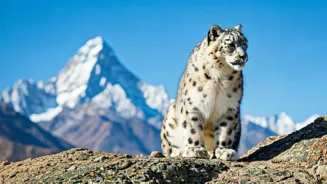Snow Leopard's Realm
The snow leopard, a master of camouflage, reigns supreme in the high-altitude regions of the Himalayas. These elusive creatures, perfectly adapted to the harsh
mountain environment, are known for their thick fur and powerful build, enabling them to thrive in freezing temperatures. They are often found in rocky terrains and steep cliffs, where they hunt prey like blue sheep and ibex. Their spotted coat blends seamlessly with the rocky landscape, making them incredibly difficult to spot. Conservation efforts are crucial for protecting this endangered species, which faces threats from habitat loss and poaching. These creatures are a true spectacle of the Himalayas, symbolizing the strength and resilience of life in the highest mountains. Spotting one is a rare and unforgettable experience.
Red Panda Wonders
Red pandas, with their striking reddish-brown fur and bushy tails, are another iconic species found in the Eastern Himalayas. These arboreal animals are primarily herbivores, feeding on bamboo shoots, fruits, and eggs. They are well-adapted to life in the trees, with sharp claws and agile movements allowing them to climb with ease. Red pandas are generally solitary creatures, except during the mating season. Their unique appearance and playful nature have made them a beloved symbol of the Himalayas. However, their populations are threatened by habitat loss and fragmentation due to deforestation. Conservation initiatives are vital to ensure their survival, focusing on habitat preservation and anti-poaching measures, offering a unique glimpse into the fragile beauty of the Himalayan ecosystem.
Blue Sheep’s Domain
Blue sheep, despite their name, have a grayish-blue coat, especially during the winter season. These fascinating animals are well-adapted to the high-altitude grasslands and rocky terrains of the Himalayas. They are social creatures, often found in herds, providing protection from predators like snow leopards and wolves. They are herbivores, grazing on grasses and herbs. The blue sheep play a critical role in the ecosystem, and their presence indicates a healthy environment. Their ability to navigate steep cliffs and their keen eyesight make them well-suited for their challenging habitat. Witnessing a herd of blue sheep grazing on the slopes is a testament to the resilience of wildlife. Their conservation is essential, as they are a vital link in the mountain's food chain.
Himalayan Monal's Beauty
The Himalayan monal, also known as the Impeyan pheasant, is a vibrant bird with iridescent plumage, making it a striking sight in the Himalayan forests. Males showcase colorful feathers, including a metallic green head, while females have a more subdued appearance. These birds are found in the forests and rocky slopes, foraging for seeds, insects, and plant material. They are often spotted in pairs or small flocks. The monal is not only a beautiful sight but also a crucial part of the ecosystem, as it contributes to seed dispersal. Their presence signifies a healthy and flourishing habitat. Their conservation is essential, as they face threats from habitat loss and hunting. Witnessing the vibrant plumage of the Himalayan monal is a treat and a symbol of the area’s natural splendor.
Other Notable Animals
Beyond the mentioned species, the Himalayas are home to numerous other intriguing animals. The elusive Tibetan wolf, adapted to the harsh cold environment, plays a role in maintaining the balance of the ecosystem. The Himalayan brown bear, a large omnivore, can be found in high-altitude forests, foraging for food. The musk deer, known for its distinct scent glands, is a crucial part of the forest's biodiversity. The black-necked crane, a majestic bird, graces the high-altitude wetlands. The Himalayan marmot, a burrowing rodent, is a common sight in the alpine meadows. Several species of ibex, wild goats adapted to the rocky terrains, also inhabit these mountains. These animals, each with unique adaptations and roles, contribute to the rich biodiversity of the Himalayas. The preservation of their habitats is critical for safeguarding this invaluable ecosystem.
Trip Planning Tips
Planning a trip to spot these animals requires careful preparation. The best time to visit the Himalayas for wildlife viewing is typically during the spring and summer months when the weather is more favorable and the animals are more active. Research specific locations within the Himalayas where these animals are commonly found, such as national parks and protected areas. Hiring a local guide is recommended, as they possess valuable knowledge about wildlife and their habits. Bring appropriate gear, including warm clothing, sturdy hiking boots, and binoculars for spotting animals. Be patient and respectful of the environment, and always adhere to wildlife viewing guidelines. Remember to carry a camera to capture the unforgettable sights. Responsible tourism practices are crucial to minimize our impact on the environment and contribute to conservation efforts. Enjoy the beauty and wonder of the Himalayas, and the amazing animals.
Conservation Efforts
The unique wildlife of the Himalayas faces threats from habitat loss, climate change, and human activities. Many conservation initiatives are underway to protect these animals. National parks and protected areas provide vital habitats for endangered species, along with the establishment of wildlife corridors. Anti-poaching measures are essential to protect the animals from illegal hunting. Community-based conservation programs engage local communities to promote sustainable practices, such as eco-tourism, which benefits both the environment and the locals. Research and monitoring efforts are also essential to understand population dynamics, habitat requirements, and the impact of climate change. Supporting these conservation initiatives through donations, volunteering, or simply being a responsible traveler can make a significant difference in the protection of the Himalayas' unique wildlife.


